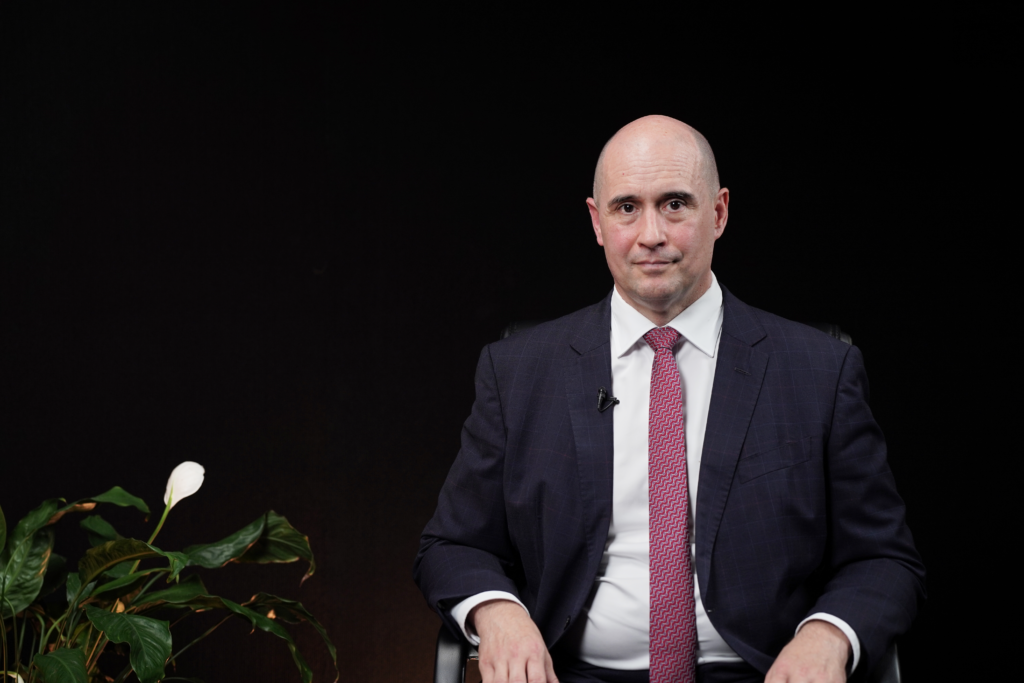Sunday, 28 December 2025
Thailand-Cambodia ceasefire begins after weeks of deadly clashes

Cambodia's Defence Minister Tea Seiha and Thailand's Defence Minister Natthaphon Narkphanit after the ceasefire was agreed during a special meeting at a border checkpoint in Chanthaburi province, Thailand
- Published
A ceasefire between Thailand and Cambodia has come into effect along the border, where almost three weeks of deadly clashes have forced nearly one million people from their homes.
In a joint statement, the defence ministers of the two countries agreed to freeze the front lines where they are now, ban reinforcements and allow civilians living in border areas to return as soon as possible.
The ceasefire took effect at noon local time (05:00 GMT) on Saturday. Once it has been in place for 72 hours, 18 Cambodian soldiers held by Thailand since July will be released, the statement said.
The breakthrough came after days of talks between the two countries, with diplomatic encouragement from China and the US.
The agreement prioritises getting the displaced back to their homes, and also includes an agreement to remove landmines.
Thailand's Defence Minister Natthaphon Narkphanit described the ceasefire as a test for the "other party's sincerity".
"Should the ceasefire fail to materialise or be violated, Thailand retains its legitimate right to self-defence under international law," he told reporters.
Saturday, 27 December 2025
Pope Leo XIV Urges Ceasefire in Cambodia–Thailand Conflict in First Christmas Message

Friday, 26 December 2025
APSARA Authority Condemns Thai Aggression, Cites Civilian Deaths and Heritage Destruction

Thursday, 25 December 2025
Wednesday, 24 December 2025
Tuesday, 23 December 2025
Monday, 22 December 2025
Thailand says will not be 'pressured' into 'disadvantaged position' at ASEAN meeting on conflict with Cambodia
Khmer Circle:
Just ask oneself : 'Who suffers more' in a fight between two protagonists of disproportionately unequal strength and the answer will confirm as to who wants and started the conflict.
^^^
'Thailand has consistently expressed its desire for lasting peace, and Cambodia must demonstrate sincerity in this matter,' Foreign Ministry says ahead of ASEAN meeting in Malaysia

ISTANBUL
Thailand said on Saturday that Bangkok will not be "pressured or put at a disadvantage" during the Association of Southeast Asian Nations (ASEAN) Foreign Ministers' Meeting on Monday, which will discuss the ongoing border conflict between Thailand and Cambodia.
Foreign Ministry deputy spokesperson Maratee Nalita Andamo said Foreign Minister Sihasak Phuangketkeow would lead a delegation to Malaysia for the discussions, according to the local news website The Nation.
"Thailand’s stance remains clear: the country seeks peace and does not pose a threat or encroach upon the sovereignty of other nations. Thailand has consistently expressed its desire for lasting peace, and Cambodia must demonstrate sincerity in this matter," she said.
The Thai Army has also condemned Cambodia for its "use of violence against civilian targets," launching BM-21 rockets that hit homes and the Phanom Dong Rak Hospital.
Meanwhile, Cambodia said Thailand bombed Cambodian territory with F-16s, according to the Khmer Times.
Thai jets also destroyed O’ Jik Bridge, located along the border between Siem Reap and Oddar Meanchey provinces, late Friday, it said, adding that on Saturday, civilian areas, including private commercial buildings and a primary school in Thmor Da district, Pursat province, were also targeted.
China's Special Envoy for Asian Affairs, Deng Xijun, has also visited Phnom Penh to discuss efforts to de-escalate and bring an end to the ongoing conflict, a statement from the Cambodian Foreign Ministry said Saturday.
Sunday, 21 December 2025
Saturday, 20 December 2025
US asks Thailand to take ‘concrete actions’ towards de-escalation with Cambodia
Khmer Circle:
Does the US still believe Thailand is using US-made fighter jets for defensive purposes? The same question must apply to Sweden who sold military aircrafts to Thailand purportedly for the same reasons.
^^^
US Secretary of State Marco Rubio has phone call with Thai Foreign Minister Sihasak Phuangketkeow

- Bangkok also confirms Cambodian forces shot down Thai reconnaissance drone
ANKARA
The US has asked Thailand to take "concrete actions' toward de-escalation with Cambodia amid ongoing border clashes between the two Southeast Asian nations.
In a Thursday phone call with Thai Foreign Minister Sihasak Phuangketkeow, Secretary of State Marco Rubio underscored Washington’s concerns about continued violence along the Cambodian border and emphasized the immediate need to reduce tensions, said State Department spokesperson Tommy Pigott in a statement.
Rubio also urged Sihasak to take concrete actions to de-escalate the situation and for Thailand to return to implementing the Kuala Lumpur Peace Accords.
Separately, Thailand on Friday confirmed that Cambodian forces shot down a Thai reconnaissance drone. Defense Minister Gen. Natthaphon Narkphanit called the loss "regrettable" but unavoidable in wartime, according to the Thai Enquirer.
He added that the downed drone was a DP-20 (D-Eyes 04) surveillance drone and acknowledged that Cambodia possesses air defense weapons capable of targeting such platforms.
Friday, 19 December 2025
ល្បិចពិសពុល ! ថៃជំរុញឲ្យកម្ពុជាឈប់បាញ់មុន បើខ្មែរយល់ព្រមមានរឿងអ្វីកើតឡើង?!
Khmer Circle: Usually a ceasefire agreement means and requires both sides to the conflict to cease fire at the same time? The Thais' logic never fails to amaze...
Opinion: In 1941, Thailand invaded Cambodia and later declared war on the United States and the United Kingdom.
By Casey Barnett, President of AmCham Cambodia
In 2025, Thai accusations that Cambodian soldiers fired across the border are again being used to justify an ongoing Thai invasion of Cambodia. Similar claims formed the basis of Thailand’s 1941 invasion of Cambodia. Then, as now, Thailand’s military action was intended to annex Cambodian territory.

Despite full knowledge of Japan’s genocidal conduct in China, including the 1937 Nanjing Massacre in which approximately 200,000 civilians and prisoners of war were killed, Thailand entered into a treaty with Japan on June 12, 1940.² This agreement laid the groundwork for Japan’s subsequent occupation of French Indochina and British Malaya. After ratifying the treaty, Thailand invaded Cambodia and Laos in January 1941, claiming that French colonial forces in Cambodia had fired across the border into the Thai town of Aranyaprathet. In reality, Thailand had been preparing for invasion for months.³ Within weeks, Thailand forcibly annexed northern Cambodian provinces and western Lao territories.⁴
In December 1941, Thailand and Japan concluded a further agreement providing for mutual military support, with Japan explicitly backing Thailand’s territorial claims covering annexed areas of Cambodia, Laos, Malaya, and Burma.⁵ This agreement secured Thailand’s role as a logistics hub and staging ground for Japan’s conquest of British Malaya and Burma between 1941 and 1942.⁶

In July 1943, Japan rewarded Thailand for its cooperation by transferring to it six provinces of British Malaya and Burma.⁷ During this period, Thailand facilitated and materially benefited from Japan’s use of forced labor to construct the Burma Railway, linking Bangkok to Yangon.⁸ Among the enslaved laborers were 30,131 British and 686 American prisoners of war. Of these, 6,904 British and 131 Americans died as a result of brutal working conditions.⁹
Following the Allied victory in World War II, Thailand was compelled to relinquish all territories it had annexed in Cambodia, Laos, Malaya, and Burma. Britain initially sought punitive measures, including extended occupation of Thailand and potential control over the Thai Isthmus.¹⁰ The United States, however, opposed harsh postwar treatment, arguing that severe demands would destabilize Thailand and the wider region.¹¹ As a result, Thailand faced limited accountability for its wartime territorial aggression.
Now, in 2025, with little apparent collective memory of the consequences of its earlier irredentist ambitions, Thailand is once again invading Cambodia.
Thursday, 18 December 2025
Cambodia Says It’s Ready as Thai Navy Eyes Gulf Supply Disruptions

This photo shows daily activities at the Sihanoukville Autonomous Port, Preah Sihanouk province. Photo: Sihanoukville Autonomous Port/Facebook
By:Meng Seavmey
December 15, 2025, 12:20 PM
PHNOM PENH — Cambodia has sought to project confidence and preparedness after reports that the Thai Navy is considering measures that could disrupt fuel and strategic goods shipments to Cambodia through the Gulf of Thailand, a move analysts warn would raise serious legal and regional concerns.
According to a December 14 report by Khaosod, the Thai Navy said it would submit a proposal to Thailand’s National Security Council on December 15 that includes suspending fuel and strategic goods exports to Cambodia, intensifying monitoring of Cambodian commercial vessels, and designating waters near Cambodian ports as high-risk zones, citing alleged indiscriminate fire from Cambodia.
While the Navy reportedly insisted that the plan would not amount to a formal blockade of the Gulf of Thailand, Cambodian officials dismissed the proposal as ineffective and said alternative supply routes are already in place.
Phan Rim, spokesperson for Cambodia’s Ministry of Public Works and Transport, said the country’s logistics networks would not be disrupted, stressing that contingency planning had been completed well in advance.
“Cambodia is not unprepared,” Rim said. “The government has already assessed multiple scenarios and put in place response mechanisms to ensure supply continuity in all circumstances.”
He added that Cambodia maintains a range of coordinated maritime and inland supply routes that comply with international law and safeguard the country’s economic independence.
“Cambodia has diversified waterway routes with sufficient capacity to guarantee sovereign control and operational continuity under international legal frameworks,” Rim said.
Sam Suen, a Phnom Penh-based policy analyst and researcher at the Royal Academy of Cambodia, said the government’s early planning was critical to preventing supply shocks, particularly as fighting along the border shows no sign of easing.
He warned that the Thai proposal was likely to gain traction domestically, given the political and military dynamics in Bangkok.
“This scenario is plausible because the focus appears to be on coercive measures rather than diplomatic solutions,” Sam Suen said. “Thailand has increasingly sidelined peaceful international mechanisms, which raises the risk of prolonged disruption.”
He also stressed that any unilateral attempt to restrict access in the Gulf of Thailand would raise serious legal questions under the United Nations Convention on the Law of the Sea (UNCLOS).
“The Gulf is not an area that any single state can control at will,” he said. “Thailand must clearly distinguish between its territorial waters, Cambodia’s and Vietnam’s territorial seas, and international waters. Failure to do so would constitute a violation of UNCLOS.”
Sam Suen called on the international community to closely monitor any implementation of the proposal should it receive official approval, warning that unchecked actions could set a destabilizing precedent in regional waters.
He also urged Cambodia to formally notify the United Nations Security Council and to engage international maritime law experts to assess territorial boundaries and navigational rights in the affected areas.
“Legal clarity and international oversight are essential,” he said. “This is not only a bilateral issue but one that affects regional stability and freedom of navigation.”
Cambodia Advises Alternative Routes for European Travelers

A Cathay Pacific Airbus A321-251NX prepares to land on the runway on the inauguration day of the newly built Techo International Airport in Kandal province, on the outskirts of Phnom Penh, on September 9, 2025. Photo by AFP
SIEM REAP – The Cambodian Embassy in France has advised European travelers heading to Cambodia to avoid transiting through Thailand, citing reports of tourists facing what it described as “thorough and unacceptable checks” at Bangkok airport.
In a statement circulated by Ambassador of Cambodia to France, the embassy said difficulties have been reported during air transits in Thailand, where European passengers bound for Cambodia were subjected to prolonged questioning before boarding, unreasonable requests for proof of financial resources and checks related to accommodation bookings in Cambodia.
In some cases, the embassy said, these checks were followed by searches and baggage handling incidents that resulted in the loss of checked luggage, which was only discovered upon arrival in Phnom Penh.
As a precaution, the embassy urged European travelers to select flight itineraries that do not involve transit through Thailand and to consider alternative airlines that offer more suitable transit conditions for travel to Cambodia.
The statement stressed that the reported incidents occurred outside Cambodian territory and fall beyond the jurisdiction of Cambodian authorities, though they may still affect travelers’ overall experience.
The embassy also reaffirmed that Cambodia remains a safe and welcoming destination for foreign tourists.
US Expert Says Thailand–Cambodia Conflict Raises Legal, Humanitarian Concerns

Smithsonian Returns Three Looted Artefacts
Cambodianess

“Head of Harihara” (mid-10th century), “The Goddess Uma” (10th century) and “Prajnaparamita (Perfection of Wisdom)” (c. 1200); Image Credit: National Museum of Asian Art, Smithsonian Institution, Photo by Robert Harrell
PHNOM PENH – Three masterpiece Khmer artefacts looted during the period of turbulence are set to return to Cambodia from the US National Museum of Asian Art.
The repatriation follows years of negotiations between the Cambodian team and the Smithsonian Institution.
The Ministry of Culture and Fine Arts said on Dec. 16 that the Smithsonian’s board of regents has formally approved the return of the Head of Harihara, 10th century, Female Deity (the Goddess Uma), 10th century, and Prajnaparamita, late 12th century.
The ministry said that the approval was cleared on Oct. 27. The three objects are on display at the institution’s National Museum of Asian Art.
The Smithsonian said an internal assessment had been conducted since 2022.
For the Head of Harihara, a deity combining Shiva and Vishnu, only half of Shiva’s third eye is visible, thus confirming the dual identity and matching those of Pre Rup Temple. The sculpture was likely acquired by William H. Wolff Inc. before 1968 and passed to Dr. Arthur M. Sackler and gifted to the museum in 1987.
The female deity, believed to be Goddess Uma, has a standing pose and is believed to be associated with Bakheng Temple. Meanwhile, the bronze statue Prajnaparamita — meaning perfection of wisdom — was donated to the museum in 2005.
Cambodia Wants Peace but Suffers Because of Thailand’s Ambitions
Cambodianess

Cambodia is a small country that has gone through decades of civil war and longs for peace. Peace is the number‑one priority for this impoverished nation. Peace is valued above everything else in the lives of the Cambodian people.
Because Cambodia is a peace‑loving country, the word “peace” appears everywhere — inside the country or abroad — wherever Cambodians are present.
During more than a week of armed conflict, Cambodians inside and outside the country have appealed to the world to help stop Thailand’s aggressive actions. But Thai leaders continue to declare war, ignoring calls from the United States and other foreign partners.
In Thailand, if any citizen dares to express an opinion urging their government to stop using military force and return to negotiations, that person is attacked and criticized by Thai society to varying degrees.
In this situation, Cambodia cannot maintain peace because the Kingdom of Thailand has nurtured expansionist thinking. Thailand’s expansionist mindset is not limited to territorial expansion through military force; the country also seeks to expand its cultural influence and claims shared or similar cultural heritage of some Asian nations as its own.
EU Urges Cambodia and Thailand to Restore Ceasefire, Offers Satellite Monitoring Support
Cambodianess

Wednesday, 17 December 2025
Thailand demands unilateral ceasefire announcement from Cambodia
Bangkok says Phnom Penh must be first to declare a ceasefire and cooperate ‘sincerely’ on demining the border.

By Al Jazeera Staff and News Agencies
Published On 16 Dec 202516 Dec 2025
Thailand has demanded Cambodia must be the first to declare a halt in fighting in order to bring an end to the latest round of clashes between the southeast Asian neighbours.
“As the aggressor onto Thai territory, Cambodia must announce the ceasefire first,” Foreign Ministry spokesperson Maratee Nalita Andamo said during a briefing in Bangkok on Tuesday, the AFP news agency reported.
She added that Cambodia must also cooperate “sincerely” in efforts to clear landmines in the border regions.
There was no immediate response from Cambodia. Each country has blamed the other for instigating the clashes, claiming self-defence and blaming the other for attacks on civilians.
Dozens killed
Fighting between the neighbours, prompted by longstanding rival claims to territory along their 817km (508-mile) land border, was reignited by a skirmish on December 7.
The renewed clashes at various locations have killed at least 32 people, including soldiers and civilians, on either side of the border, and displaced some 800,000, officials said.
Tuesday, 16 December 2025
Thailand’s Political Suicide by Undermining China’s Achievements in Cambodia

Monday, 15 December 2025
Why the Thailand-Cambodia ceasefire is failing
The truce did not address the root cause of the conflict. A new initiative with a clear enforcement mechanism is needed.
By Ronny P Sasmita
Senior international affairs analyst at the Indonesia Strategic and Economics Action Institution.
Published On 14 Dec 202514 Dec 2025

Yet that promise evaporated almost as soon as the delegations returned home. Bangkok’s air strikes on Cambodian positions in contested border pockets triggered immediate evacuations.
What this sequence reveals is painfully familiar. Ceasefires in this dispute have rarely been more than pauses in a long cycle of distrust. Agreements are signed in conference halls, but the frontier itself has its own rhythm – one shaped by longstanding grievances, competing national narratives and the difficulties of managing heavily armed forces operating in ambiguous terrain.
The ceasefire endorsed at the ASEAN summit was constructed as the foundation for a broader roadmap. It committed both sides to cease hostilities, halt troop movements and gradually scale down the deployment of heavy weapons near contested areas. Crucially, it tasked ASEAN with deploying monitoring teams to observe compliance.
Sunday, 14 December 2025
Saturday, 13 December 2025
Cambodia shuts border crossings with Thailand as fighting continues

Trump had already announced a deal to stop the fighting between the neighbours
- Published
Cambodia has shut its border crossings with Thailand, as fighting continues between the two forces on Saturday despite US President Donald Trump earlier saying they had agreed to a ceasefire.
The crossings will be closed until further notice, according to Cambodia's interior ministry.
Earlier, Thai Prime Minister Anutin Charnvirakul said he told Trump a ceasefire would only be possible after Cambodia had withdrawn all its forces and removed landmines.
Thai officials said four soldiers were killed on Saturday, as both sides reported continued bombing and artillery exchanges. Cambodia has not been updating its military casualty figure.
Cambodia's defence ministry said that Thai fighter jets bombed hotel buildings and a bridge, while Thailand reported several civilians were injured in a Cambodian rocket attack.
The four deaths on Saturday bring Thailand's total military death toll since Monday to 15, with 270 others injured. It added that six civilians had also been injured.
On Friday, Cambodia said at least 11 civilians had been killed and 59 others injured.
At least 700,000 people have been evacuated on both sides of the border.
Trump had claimed earlier in the week that he could stop the fighting between Thai and Cambodian forces that broke out on Monday just by picking up the phone.
Trump says Thailand and Cambodia agree to 'cease all shooting'
By Trevor Hunnicutt and Panarat Thepgumpanat
December 12, 20257:50 PM GMTUpdated 6 hours ago

Summary
Trump says both countries have agreed to return to ceasefire
Thai PM makes no mention of deal, says Trump call 'went well'
Malaysia PM says he spoke to Trump
Thai army has said it wants to decimate Cambodia's military capability
WASHINGTON/BANGKOK, Dec 12 (Reuters) - Thailand and Cambodia have agreed "to cease all shooting" effective Friday, U.S. President Donald Trump said after calls with the countries' leaders to try to salvage a ceasefire he brokered earlier this year after a fifth day of fighting.
Trump said he had spoken to Thai Prime Minister Anutin Charnvirakul and Cambodian premier Hun Manet "concerning the very unfortunate reawakening of their long-running war" and both had agreed to end the conflict.
The Reuters Daily Briefing newsletter provides all the news you need to start your day. Sign up here.
"They have agreed to CEASE all shooting effective this evening, and go back to the original Peace Accord," Trump wrote on Truth Social.
"Both Countries are ready for PEACE and continued Trade with the United States of America."
Cambodia and Thailand have since Monday been firing rockets and artillery at multiple points along their disputed 817-km (508-mile) border, in some of the heaviest fighting since a five-day clash in July that Trump halted with calls to both leaders to end their worst conflict in recent history.
BREAKING: Thailand and Cambodia have agreed to renew the ceasefire following recent deadly clashes, effective Friday, according to US President Donald Trump
Khmer Circle: Let's hope so but, knowing the Thais they'll likely break yet another agreement by claiming one or two of their soldiers step on the land mines laid by Cambodia ...
^^^






